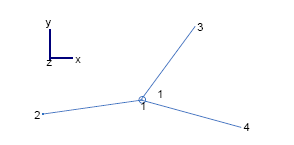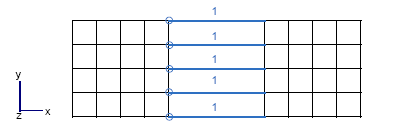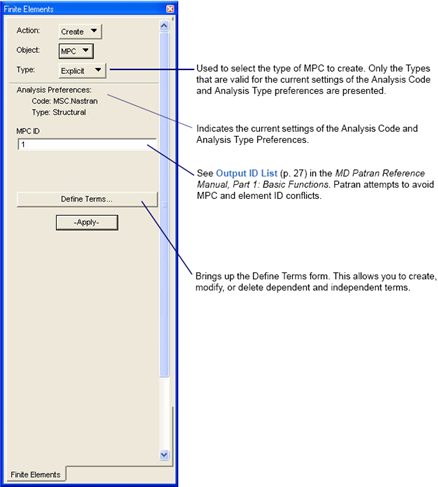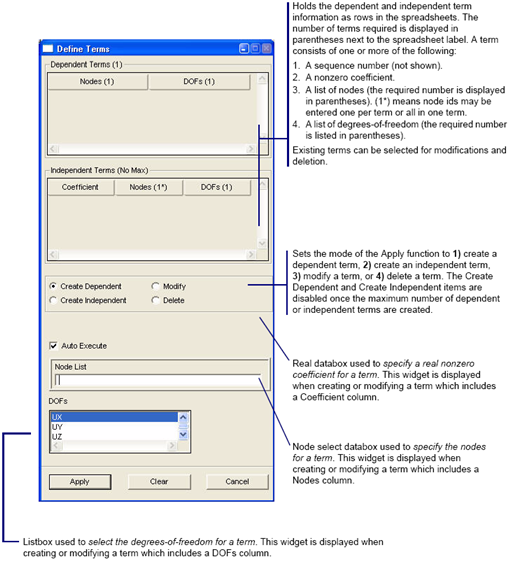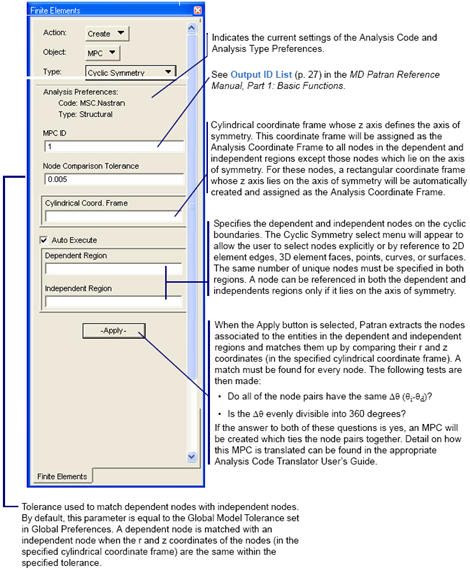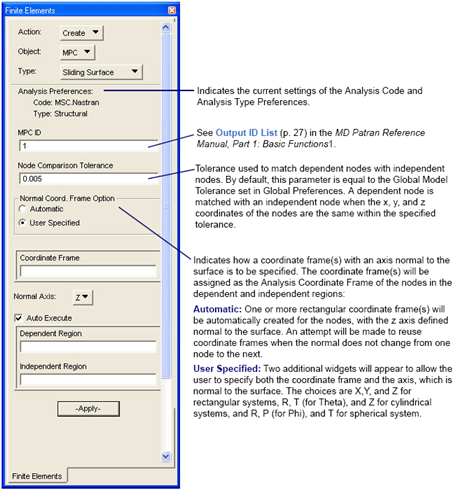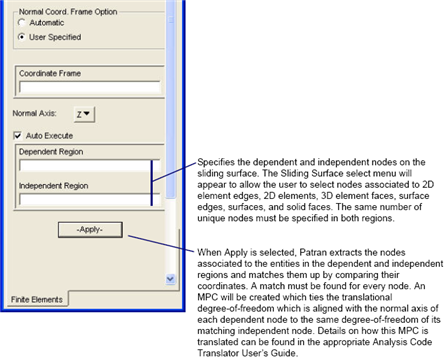XXXXXXXXXXXXXXXXXXXXXXXXXXXXXXXXXXXXXXXXXXXXXXXXXXXXXXXXXXXXXXXXXXXXXXXXXXXXXXXXXXXXXXXXXXXXXXXXXXXXXXXXXXXXXXXXXXXXXXXXXXXXXXXXXXXXXXXXXXXXXXXXXXXXXXXX''"> Creating MPCs
Overview
An MPC (multi-point constraint) is a constraint that defines the response of one or more nodal degrees-of-freedom (called dependent degrees-of-freedom) to be a function of the response of one or more nodal degrees-of-freedom (called independent degrees-of-freedom). The general form of the MPC, which most of the major structural analysis codes support (referred to as the explicit MPC type in Patran) is as follows:
(3‑1)U0 = C1U1 + C2U2 + C3U3 + ... + CnUn + C0
Where U0 is the dependent degree-of-freedom, Ui the independent degrees-of-freedom, and Ci the constants. The term to the left of the equal sign is called the dependent term and the terms to the right of the equal sign are called the independent terms. C0 is a special independent term called the constant term.
An example of an explicit MPC is:
(3‑2)UX(Node 4) = 0.5*UX(Node 5) - 0.5*UY(Node 10) + 1.0
which specifies that the x displacement of node 4 is equal to half the x displacement of node 5 minus half they displacement of node 10 plus 1.0. There are four terms in this example, one dependent term, two independent terms, and a constant term.
MPC Types
MPCs can be used to model certain physical phenomena that cannot be easily modeled using finite elements, such as rigid links, joints (revolutes, universal, etc.), and sliders, to name a few. MPCs can also be used to allow load transfer between incompatible meshes. However, it is not always easy to determine the explicit MPC equation that correctly represents the phenomena you are trying to model.
To help with this problem, many analysis codes provide special types of MPCs (sometimes called “implicit” MPCs) which simulate a specific phenomena with minimum user input. For example, most analysis codes support an implicit MPC type which models a rigid link, in which an independent node is rigidly tied to one or more dependent nodes. All the user is required to input are the node IDs. The analysis code internally generates the “explicit” MPCs necessary to cause the nodes to act as if they are rigidly attached.
In addition to the implicit MPC types supported by the analysis code, there are implicit MPC types supported by the analysis code translator. These are converted into “explicit” form during the translation process. This allows Patran to support more MPC types than the analysis code supports itself.
Patran supports the creation of all MPC types through the use of a single form, called
Create MPC Form (for all MPC Types Except Cyclic Symmetry and Sliding Surface), with two exceptions: the Cyclic Symmetry and Sliding Surface MPC types. These two MPC types have special capabilities which require special create forms. See
Create MPC Cyclic Symmetry Form and
Create MPC Sliding Surface Form.
Before creating an MPC, first select the type of MPC you wish to create. Once the type has been identified, Patran displays the proper form(s) to create the MPC.
A list of the MPC types which are supported by the MSC analysis codes can be found in the application module User’s Guide or application Preference Guide for the respective analysis code. You will only be able to create MPCs which are valid for the current settings of the Analysis Code and Analysis Type preferences. If the Analysis Code or Analysis Type preference is changed, all existing MPCs, which are no longer valid, are flagged as such and will not be translated. Invalid MPCs are still stored in the database and are displayed, but they cannot be modified or shown. However, they can be deleted. An invalid MPC can be made valid again by setting the Analysis Code and Analysis Type preferences back to the settings under which the MPC was originally created.
MPC Terms
The principal difference between one MPC type and the next is the number and makeup of the dependent and independent terms. A term is composed of up to four pieces of information:
1. A sequence number (used to order dependent and independent terms with respect to each other).
2. A nonzero coefficient.
3. One or more nodes.
4. One or more degrees-of-freedom.
For example, a dependent term of the explicit MPC type consists of a single node and a single degree-of-freedom, while an independent term of the explicit MPC type consists of a coefficient, a single node, and a single degree-of-freedom. As another example, the dependent and independent terms of the Rigid (fixed) MPC type consist of a single node.
The number of dependent and independent terms required or allowed varies from one MPC type to the next. For example, the Explicit MPC type allows only one dependent term while allowing an unlimited number of independent terms. Conversely, the Rigid (fixed) MPC type allows one independent term while allowing an unlimited number of dependent terms. Other MPC types allow only one dependent and one independent term, or one dependent and two independent terms.
Degrees‑of‑Freedom
Whenever one or more degrees-of-freedom are expected for an MPC term, a listbox containing the valid degrees-of-freedom is displayed on the form. A degree-of-freedom is valid if:
• It is valid for the current Analysis Code Preference.
• It is valid for the current Analysis Type Preference.
• It is valid for the selected MPC type.
In most cases, all degrees-of-freedom which are valid for the current Analysis Code and Analysis Type preferences are valid for the MPC type. There are some cases, however, when only a subset of the valid degrees-of-freedom are allowed for an MPC. For example, an MPC may allow the user to select only translational degrees-of-freedom even though rotational degrees are valid for the Analysis Code and Analysis Type preference.
Important: | Some MPC types are valid for more than one Analysis Code or Analysis Type preference combination. |
The degrees-of-freedom which are valid for each Analysis Code and Analysis Type Preference are listed in the analysis code or analysis code translator User’s Guide.
Important: | Care must be taken to make sure that a degree‑of‑freedom that is selected for an MPC actually exists at the nodes. For example, a node that is attached only to solid structural elements will not have any rotational degrees‑of‑freedom. However, Patran will allow you to select rotational degrees‑of‑freedom at this node when defining an MPC. |
Graphics
MPCs are displayed as a set of lines which connect each dependent node (node appearing as part of a dependent term) to each independent node (node appearing as part of an independent term). The dependent nodes are circled to distinguish them from the independent nodes (see
Figure 3‑1). MPCs are treated like elements in Patran because they:
• Can be added to or removed from groups.
• Have integer IDs which can be displayed or suppressed.
• Have their own color attribute (default = red).
Figure 3‑1 Graphical Display of an MPC with One Dependent
Node and Three Independent Nodes
Creating Multiple MPCs
In certain cases, Patran allows you to create several multi-point constraints (called Sub-MPCs) at one time which are stored as a single MPC entity with a single ID. The following rules apply:
• When an MPC requires only a single node to be specified for both dependent and independent terms, you can specify more than one node per term, as long as the same number of nodes is specified in each term. The number of Sub-MPCs that will be created is equal to the number of nodes in each term. The first node in each term is extracted to define the first Sub-MPC, the second node in each term is extracted to define the second Sub-MPC, and so on.
• When an MPC requires only a single degree-of-freedom to be specified for both dependent and independent terms, you can specify more than one degree-of-freedom per term, as long as the same number of degrees-of-freedom is specified in each term. The number of Sub-MPCs that will be created is equal to the number of degrees-of-freedom in each term. The first degree-of-freedom in each term is extracted to define the first Sub-MPC, the second degree-of-freedom in each term is extracted to define the second Sub-MPC, and so on.
• When an MPC requires only a single degree-of-freedom to be specified for the dependent terms and no degrees-of-freedom for the independent terms (or vice versa), you can specify more than one degree-of-freedom per term, as long as the same number of degrees-of-freedom is specified in each term that expects a single degree-of-freedom. The number of Sub-MPCs that will be created is equal to the number of degrees-of-freedom in each term. The first degree-of-freedom in each term is extracted to define the first Sub-MPC, the second degree-of-freedom in each term is extracted to define the second Sub-MPC, and so on.
• When an MPC requires only a single node and a single degree-of-freedom to be specified for both dependent and independent terms, you can specify more than one node and⁄or degree-of-freedom per term, as long as the same number of nodes and degrees-of-freedom are specified in each term. The number of Sub-MPCs that will be created is equal to the number of nodes times the number of degrees-of-freedom in each term.
• For all other MPC types which do not match one of the above conditions a single Sub-MPC will be created.
When multiple Sub-MPCs are created, they are displayed as shown in
Figure 3‑2, with the ID of the MPC displayed at the centroid of each Sub-MPC. The translators will treat each Sub-MPC as a separate MPC, but Patran treats the collection of Sub-MPCs as a single entity.
Figure 3‑2 The Graphical Display of an MPC Which is Made up of Five Sub‑MPCs
Create MPC Form (for all MPC Types Except Cyclic Symmetry and Sliding Surface)
When Create is the selected Action and MPC is the selected Object, the Create MPC form is displayed. Several MPC types are valid under the Type option menu.
Define Terms Form
The Define Terms form appears when the Define Terms button is selected on the Create MPC form. Use this form to define the dependent and independent terms of an MPC.
Create MPC Cyclic Symmetry Form
Use this form to Create an MPC which defines a set of cyclic symmetry boundary conditions between the nodes in two regions.
Create MPC Sliding Surface Form
Use this form to create an MPC which defines a sliding surface between the nodes in two coincident regions. The translational degree-of-freedom (normal to the surface) of coincident nodes in the two regions are tied while all others remain free.
